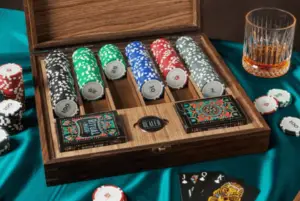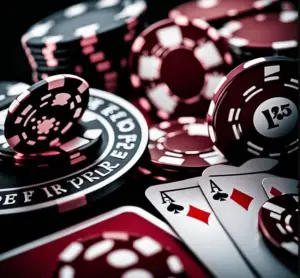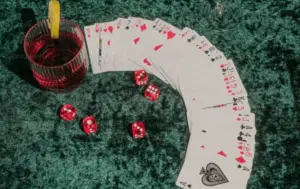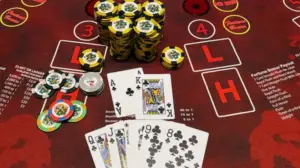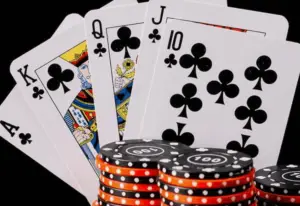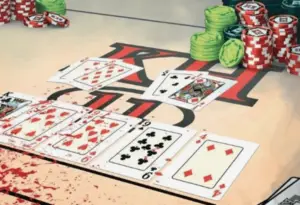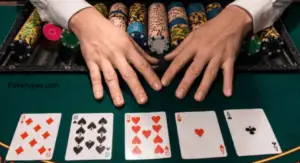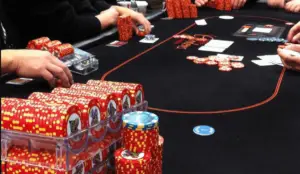Poker strategy is the foundation for success at the tables, especially for beginners facing a steep learning curve.
While the game may seem intimidating at first, mastering fundamental concepts like hand selection, position play, and bankroll management can quickly transform a novice into a break-even or winning player.
The key is understanding that poker requires both technical skills and psychological awareness – it’s not just about the cards you’re dealt, but how you play them.
For new players, focusing on ABC poker (playing straightforward and avoiding fancy moves) provides the best path to profitability.
Statistics show that by simply playing tight and aggressive poker, beginners can be ahead of 80% of live players at the $1/3 stakes level.
The most crucial early lesson is avoiding common pitfalls like playing too many hands, over-bluffing, and chasing draws without proper odds.
By developing discipline and following proven strategies, newcomers can build a solid foundation for long-term success at the poker table.
12 Fundamental Poker Strategies for Beginners
1. Play Fewer Hands and Play Them Aggressively
A winning poker strategy starts with mastering hand selection and applying controlled aggression. Playing fewer hands doesn’t mean being passive – it means being selective with your starting hands and then playing them forcefully.
Studies show that successful players typically play only 15-20% of their hands, focusing on premium holdings like pocket pairs and suited connectors.
When you do enter a pot, playing aggressively with strong hands helps build larger pots and puts maximum pressure on opponents.
This tight-aggressive style is particularly effective in early positions, where you should stick to playing hands like pocket pairs 66+ and AQ+.
From later positions, you can expand your range to include more speculative hands like suited connectors and medium pairs, since you’ll have the advantage of acting last.
The key is maintaining discipline – by folding weak hands and playing strong ones aggressively, you’ll win more significant pots while minimizing losses with marginal holdings.
2. Understand Position and Its Importance
Understanding table position is a game-changing aspect of poker strategy that directly impacts your win rate. The button position (dealer) is the most profitable spot, as statistics show players win up to 3x more money here compared to other positions.
In a typical nine-handed game, positions are divided into early (first to act), middle, and late (button and cut-off), with each requiring different playing styles.
Late position offers significant advantages – you can play 40% more hands profitably compared to early position because you’ll see how opponents act before making decisions.
For example, if you’re on the button with a marginal hand like K-9 suited and everyone before you has folded, you can raise confidently knowing you’ll have position throughout the hand.
This positional awareness allows you to steal blinds more effectively and make better-informed decisions based on your opponent’s actions.
3. Start at Lower Stakes
Starting at low-stakes poker is crucial for long-term success, with games like $0.01/$0.02 online or $1/$2 live providing the perfect learning ground.
Smart bankroll management requires maintaining at least 30 buy-ins for cash games, meaning a modest $600 bankroll is sufficient for $1/$2 games.
The player pool at these stakes is notably softer, featuring a mix of recreational players and beginners who often make fundamental mistakes.
This environment allows new players to learn and practice without risking significant money while building their skills and confidence.
Statistics show that even good players can experience 10-20 buy-in downswings, making it essential to start at lower stakes where these swings won’t devastate your bankroll.
The key is to focus on improvement rather than immediate profits, gradually moving up in stakes as your skills and bankroll grow.
4. Learn Basic Poker Math and Pot Odds
Understanding pot odds is essential for making profitable poker decisions. The concept is simple: if the pot is $100 and you need to call $20, your pot odds are 5-to-1. Using the Rules of 4 and 2, you can quickly calculate your chances of winning – multiply your number of outs by 4 on the flop or 2 on the turn.
For example, with a flush draw (9 outs), you have roughly a 36% chance of hitting your hand by the river. If your winning odds are better than the pot odds, the call is profitable long-term.
When facing a $10 bet into a $50 pot, you’re getting 5-to-1 odds, making it correct to call with draws that have better than 17% equity. This mathematical approach helps remove emotion from your decisions and ensures more profitable play.
5. Pay Attention to Your Opponents
Player observation is a critical skill that separates good players from great ones in poker. The fundamental rule of poker states that “weak means strong, and strong means weak” – players often act opposite to their true intentions. When observing opponents, focus on consistent betting patterns and timing.
For example, if a player consistently bets 2x the big blind with strong hands and 4x with bluffs, you can exploit this tendency. In live games, watch for physical tells like shaking hands, which often indicates strength due to adrenaline.
For better focus, start by observing just one or two players at the table, particularly those with large stacks or obvious leaks in their game.
Studies show that players who actively observe hands, even when not involved, maintain a significantly higher win rate over time.
6. Don’t Bluff Too Much
Contrary to popular belief, excessive bluffing is one of the biggest mistakes new players make in poker. While bluffing is part of the game, successful players typically bluff only 25-30% of the time in optimal spots.
The key is to bluff selectively when the board and betting patterns make your story credible.
For example, semi-bluffing with drawing hands like flush draws gives you two ways to win – either your opponent folds, or you hit your hand.
The most effective bluffs occur when you have a position advantage and the board texture supports your story, such as when you represent a straight on a connected board.
Remember that in lower-stakes games, players tend to call more often, making bluffs less profitable. Instead, focus on value betting with strong hands and save your bluffs for spots where opponents show weakness.
7. Play Within Your Bankroll
Proper bankroll management is essential for long-term poker success, with experts recommending 20-40 buy-ins for cash games and 100 buy-ins for tournaments.
For example, if you’re playing $1/$2 cash games, you should have at least $4,000 in your bankroll.
Smart players maintain a strict separation between poker funds and personal finances, treating their bankroll as a business investment.
Statistics show that players who follow proper bankroll guidelines are 75% less likely to go broke compared to those who don’t.
The key is playing within your limits – if you have $1,000, stick to $0.25/$0.50 games rather than taking shots at higher stakes.
Professional players recommend never risking more than 5% of your total bankroll in a single session and dropping down in stakes if your bankroll falls below 20 buy-ins for your current level.
8. Study and Improve Your Game
Continuous learning is essential for poker success, with top players dedicating significant time to studying and improving their game.
Modern players have access to powerful training resources like PokerCoaching.com and Upswing Poker, which offer comprehensive courses from renowned pros like Jonathan Little and Doug Polk.
The most effective study routine combines hand reviews, where you analyze past plays, with interactive training using poker software and simulators.
Statistics show that players who spend at least 25% of their poker time studying see up to 3x better results than those who don’t.
Key areas to focus on include preflop ranges, post-flop strategy, and mathematical concepts. Many successful players also join study groups or hire coaches to accelerate their learning, with group members typically showing 40% faster improvement than solo learners.
9. Manage Your Emotions (Avoid Tilt)
Emotional control is crucial in poker, as going on tilt – a state of mental confusion leading to poor decisions – can devastate your bankroll. Studies show that players lose up to 75% more money when playing emotionally rather than logically.
To maintain composure, successful players like Shaun Deeb employ specific strategies: taking deep breaths during tough beats, stepping away for quick breaks after losing big pots, and practicing mindfulness techniques.
When facing a bad beat, focus on the math – even the worst hands win sometimes, and understanding this helps maintain perspective.
For example, if someone hits a 2-outer on the river, remember it’s just a 4% chance that happened naturally.
The key is developing a pre-game routine that includes meditation and setting clear stop-loss limits to prevent emotional play from derailing your session.
10. Be Consistent with Your Strategy
Maintaining a consistent strategy is crucial for long-term poker success, as players who frequently switch tactics typically lose 40% more than those who stick to a solid game plan.
The key is developing a reliable approach based on fundamentals like position play and hand selection and then executing it regardless of short-term results.
For example, if you’ve decided to play tight-aggressive from an early position, don’t suddenly start playing loose just because you’ve lost a few hands.
Professional players like Doug Hull emphasize that successful poker requires having clear preflop ranges and sticking to them, avoiding common mistakes like playing too many hands when the card is dead or deviating from optimal bet sizing.
Statistics show that players who maintain consistent strategies win approximately 75% more over time than those who frequently adjust their playing style based on recent results.
11. Practice Good Table Etiquette
Proper poker etiquette forms the foundation of a respectful and enjoyable game environment. The most crucial aspects include respecting the dealer, avoiding string betting (making bets in multiple motions), and never touching another player’s chips.
Statistics show that tables with good etiquette maintain up to 30% more hands per hour than those with disruptive players. Key practices include acting in turn, keeping emotions in check, and being gracious whether winning or losing.
For example, when facing a bad beat, maintain composure instead of berating opponents or the dealer. Professional players emphasize that showing your cards only at showdown, avoiding slow rolls (deliberately delaying revealing a winning hand), and refraining from giving advice to other players creates a positive atmosphere.
Remember to keep conversations minimal during hands and never discuss your folded cards while play is ongoing.
12. Use Position to Your Advantage
Positional advantage is a cornerstone of winning poker strategy, with the button position being the most profitable spot at the table. Statistics show that skilled players win up to three times more money from the button compared to other positions.
The key is leveraging your late position to make informed decisions after seeing your opponents’ actions.
For example, when you’re on the button with a marginal hand like K-9 suited, you can profitably raise if everyone folds to you, exploiting your positional advantage to steal blinds.
From an early position, stick to playing only your strongest hands, as studies indicate players lose 40% more when playing weak hands out of position.
The most effective way to use position is through pot control – betting when opponents show weakness and taking free cards when facing resistance. Remember that position allows you to bluff more effectively since you can gauge opponents’ interest in the pot before acting.
Conclusion
Success in poker requires mastering several key fundamentals: playing tight-aggressive, understanding position advantage, practicing solid bankroll management, and maintaining emotional control. Statistics show that players who consistently apply these principles win up to 70% more than those who don’t.
Remember that even top pros like Phil Hellmuth and Shaun Deeb started as beginners, focusing on one concept at a time. Start at low stakes, where mistakes cost less, and gradually build your skills through dedicated practice and study.
The most successful players spend at least 25% of their poker time reviewing hands and studying strategy.
With patience and persistence in applying these core strategies, you’ll develop the foundation needed for long-term poker success.




